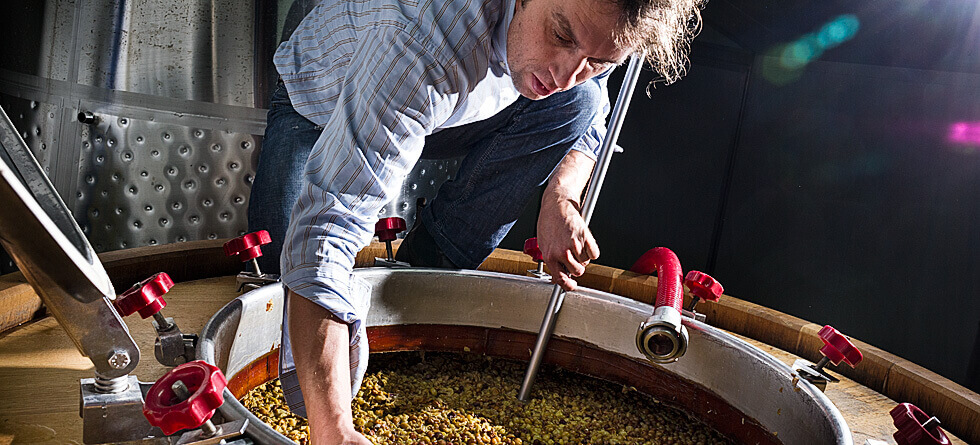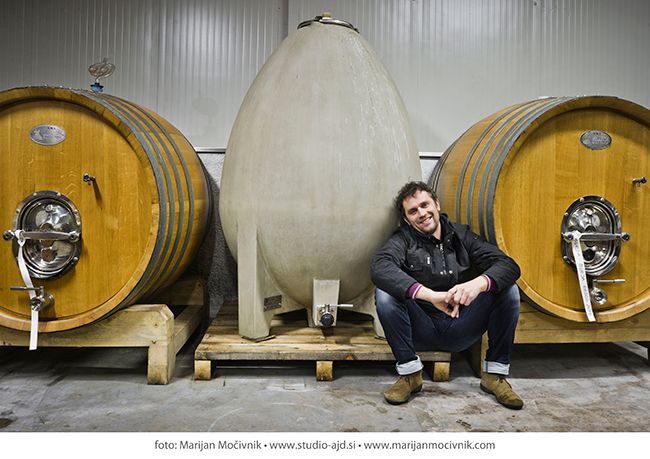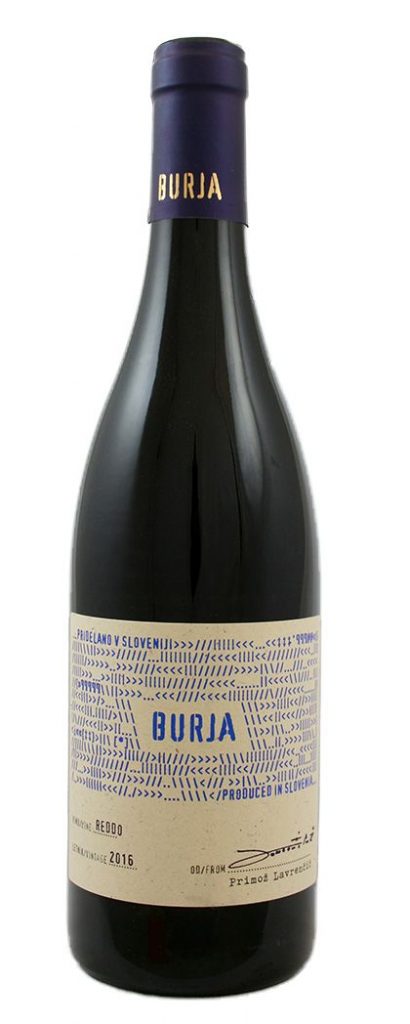What’s new: the 2019 Zelen, 2018 Reddo, and a new wine, the 2019 Roza.

Posestvo Burja, by Primoz Lavrencic, is located in the Vipavska Dolina, or Vipava Valley. Rich descriptions of Vipava viticulture and winemaking can be found in Winemaking for Slovenes (Vinoreja za Slovence), the first Slovenian book on viticulture, written by Matija Vertovec in 1844 and in The Glory of the Duchy of Carniola (1689) by Johann Weikhard von Valvasor.
According to location and natural geographic features, the Vipava Valley is very much betwixt and between, wedged between the Trnovo Plateau to the north, and Karst to the south, a mixture of Alpine, Mediterranean and Continental climates. The Vipava Valley is also the windiest part of Slovenia, noted for the gusts of its famous wind which blows with furious gusts – the bora (burja).
Respecting the local varieties, Primoz adopts a holistic approach to farming and winemaking.
Primoz Lavrencic is a progressive guy. His wines are distributed by our colleagues, Les Caves Italia, and he is married to Benjamin Zidarich’s sister, so we have plenty of things in common. The Lavrencic family moved in the Vipava Valley as far back as 1499, and like the majority of the population, engaged in agriculture and viticulture. Primoz’s mother’s family were blacksmiths, and also owned some vineyards.
I am indebted to the Indie Wineries website for its explanation of Primoz’s philosophy.
Primoz Lavren?i? is a lifelong student of classical philosophy and applies it to his winemaking artistry. In the vineyard he describes his approach as being based on Aristotle’s “The Metaphysics,” which is also informed by his personal Spinozan Pantheistic approach.
“The key in the great amount of the wines from all over the world remains the question of dualistic paradigm – so is the idea of wine the same for all wines? So would the idea exist in an extrasensory Platonic space or is the idea expressed in each wine separately and in its indivisible part?”
Primoz believes, that wines from different places, different cellars, different winemakers, all contain their own idea, or essence. Wines should be bottled as their own individual expression, sui generis. They are bottled as their own expression. Primoz find that wines that yield to the terroir are the freest in their individual expression. The wines he crafts are meant to act as a sort of proof for this thesis. He recognizes that the experience of a wine depends on the knowledge, culture and past experience of the drinker, thus it’s a fact that the same wine can generate different, even contradictory experiences.
I suspect Primoz would slightly deprecate the idea that he was a Spinozan Pantheistic vigneron. (Membership of this movement: one). Respecting the local varieties, however, Primoz adopts a holistic approach to farming and winemaking. He grows varieties that originate in Vipava Valley and along the northern Adriatic coast, namely: Zelen, Pokalca (Schioppettino), Refošk (Refosco), Rebula (Ribolla Gialla), Malvazija (Malvasia d`Istria), Laški rizling (Italian Riesling, Welschriesling), There is also some Modra frankinja (Blaufränkisch), whilst he inherited a vineyard of Modri pinot (Pinot Noir) that has become his not-so-secret-passion (as a committed Burgundo-phile).
The diversity and richness of the vineyards is impressive. He believes that a thriving microflora are an integral part of each vineyard’s identity and encourages their proliferation by practicing organic and biodynamic farming. He appreciates the nuances of soil type and climate diversity in individual locations, and farms accordingly.
Primoz’s wines are playful. As befits the darting mind of the vigneron and the stony soils and the climatic and microclimatic niceties, they are sharp at their core with dancing freshness.
In the winery Primoz only controls a few things such as temperature and the degree of oxidation in the cellar. He allows spontaneous fermentation and ensures contact between grape skin and must with the white wines. The diversity of yeast strains contributes to the complexity of the wine and provides an original expression of each vineyard.
The vineyards have their roots in sedimentary flysch, the composition of which differs significantly according to lithologic varieties of the bedrock below the soil. In Zadomajc and Ravno Brdo sandstone and marlstone form the bedrock. Marlstone prevails a little, causing middle heavy ground, which retains moisture quite well. It is a similar situation in Stranice, except that marlstone is even more prevalent over sandstone, resulting in even heavier and wetter ground. In the biggest vineyard in Golavna the soil lies over tough sandstone, is thinner, lighter and dries faster. The vineyards behind the winery/house are oriented in various directions. They are surrounded by forest and overlook the village. In the cleft of one of the vines we find a tiny owl’s nest. The views are amazing and you feel good things will come from here.
The multi-floored gravity “Hollywood winery”, built into the rocks under one of the vineyards and cooled by the water in the hill, is nearly finished now. One walks through a room with a formidable array of cement eggs on one side and larger concrete tanks on the other, down into the cellar room with its Slavonian oak barrels taste Primoz’s wines.

Wines:
In no particular order…
Burja Bela is based on the former glory of the Vipava white wine, Vipavec (win von Wippach). This blend comprises Laški rizling (Italian Riesling, Welschriesling) 30%, Rebula (Ribolla Gialla) 30%, Malvasia 30 %, other varieties 10 % and is a field blend of the two oldest vineyards: Ravno brdo over 20 years old and Stranice over 60 years old with the different vines growing side by side. This wine is aged for one year in foudres of 20-35 hl.

Burja Reddo sees Primoz playing with the idea of former red wine varieties in the Vipava Valley, which were once in minority. Pokalca (Schioppetino) 50%, Modra frankinja (Blaufränkisch) 30% and Refošk (Refosco) 20% make up this red blend, the grapes coming from young vineyards, from 4 to 6 years old. Also aged for two years in large barrels (10 to 15 hl). Super-elegant with aromatic notes of red and dark currants encased in delicate oak, and a fine seam of acidity running through it.
Primoz’s wines are playful. As befits the darting mind of the vigneron and the stony soils and the climatic and microclimatic niceties, they are sharp at their core with dancing freshness.
Tasting the 2019 Zelen one can already see the considerable progress over the years. This wine, from a native Vipavan grape (Zelen means green in Slovenian), is fermented in eggs and raised in cement vats. Reminiscent of citrus and apples, with undertones of green herbs, particularly sage, it is elegant and saline on the palate, while being equally rich and harmonious. Somewhere between a lees-aged Muscadet and a mini-Vitovska. The skin contact (approximately 8-days) imbues the Zelen with extra layers of flesh.
Roza is the newest addition to the Burja family. This comes from a 0.40 ha Pinot Gris vineyard owned by Primoz’s friend and neighbour. The grapes undergo a five-day maceration and then spontaneous fermentation in concrete vats with indigenous yeasts and natural malo. Further ageing on the lees takes place in concrete and the wine is bottled without filtration and just a tiny amount of SO2.
2019 Zelen
2018 Bela
2019 Roza
2018 Reddo
*
Interested in finding more about the wines mentioned? Contact us directly:
shop@lescaves.co.uk | sales@lescaves.co.uk | 01483 538820
*Note: We are still open for business, doing deliveries, and keen to help everyone with their booze needs in this difficult time. Natural wine lovers can visit our online shop and order online!

